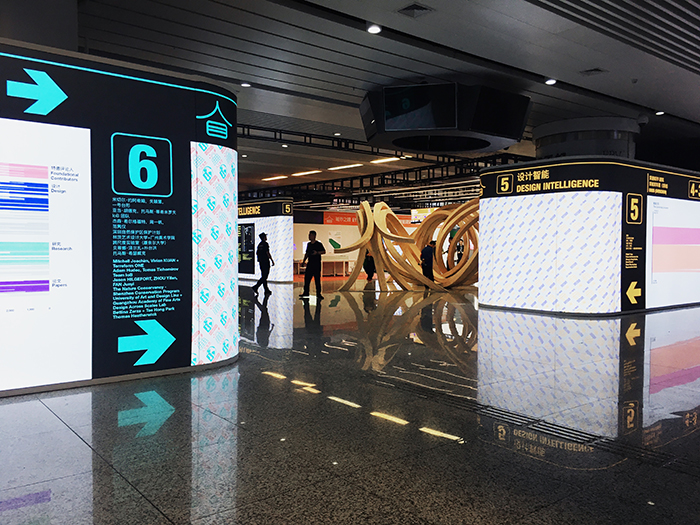SZ/HK Biennale UABB "Eyes of the City"
- LxB

- Dec 22, 2019
- 4 min read
Updated: Jun 14, 2020
SZ/HK Bi-City Biennale 2019 Main Venue @ Futian Station

Lapis Bureau contributed successfully to the design, development and realisation of the "Eyes of the City" main exhibition during the Shenzhen Biennale 2020, together with Carlo Ratti Associati, Politecnico di Torino and South China University as main curators.
Freddy Curiél has been in charge as Executive Production Manager of the realisation of the main venue exhibition interiors design and of over 60 installations from different architects and artists all around the world.
Curatorial statement by Carlo Ratti, Michele Bonino, Sun Yimin
Observing people’s presence in physical space and deciphering their behaviors have always been critical actions to designers, planners and anyone else who has an interest in exploring how cities work. It was 1961 when Jane Jacobs, in her seminal book “The Death and Life of Great American Cities”, coined a famous expression to convey this idea. According to Jacobs, “the natural proprietors” of a certain part of the metropolis – the people who live, work or spend a substantial amount of time there – become the “eyes on the street.” Their collective, distributed, decentralized gaze becomes the prerequisite to establishing “a marvelous order for maintaining the safety of the streets and the freedom of the city.”
Almost half a century later, we find ourselves at the inception of a new chapter in the relationship between the city and digital technologies, which calls for a reexamination of the old “eyes on the street” idea. In the next few years, thanks to the most recent advances in Artificial Intelligence, deep learning and imaging, we are about to reach an unprecedented scenario, the most radical development in the evolution of the Internet-of-Things: architectural space is acquiring the full ability to “see.” Imagine that any room, street or shop in our city can recognize you, and autonomously respond to your presence. With Jacobs’s “eyes on the street,” it was people who looked at other people or the city and interpreted its mechanisms. In this new scenario, buildings and streets similarly acquire the ability to observe and react as urban life unfolds in front of them. After the “eyes on the street,” we are now entering the era of the “Eyes of the City.” What happens, then, to people and the urban landscape when the sensor-imbued city is able to gaze back?
What we are currently facing is an “utopia or oblivion” crossroads, to say it with the words of one of the most notable thinkers of the past century, Richard Buckminster Fuller. We believe that one of the fundamental duties of architects and designers today is to grapple with this momentous shift, and engage people in the process. “Eyes of the City” aims to experiment with these emerging scenarios to better comprehend them, deconstructing the potential uses of new technologies in order to make them accessible to everyone and inspire people to form an opinion. Using critical design as a tool, the exhibition seeks to create experiences that will encourage people to get involved in defining the ways in which new technologies will shape their cities in years to come. For this reason, it recognizes in Shenzhen’s Futian high-speed railway station its natural home – a place where to reach a broad, diverse audience of intentional visitors and accidental passersby, and a space where, just like in most other liminal transportation hubs, the impact of an “Eyes of the City” scenario is likely going to be felt the most.
Chief Curator:
Carlo Ratti
Academic Curator:
Politecnico di Torino – Michele Bonino 博明凯
South China University of Technology (SCUT) – Sun Yimin
(South China-Torino Lab)
Executive Curators:
Daniele Belleri (CRA-Carlo Ratti Associati)
Edoardo Bruno (Politecnico di Torino)
Xu Haohao (SCUT)
CURATORSHIP
Head Curator of Editorial and Events:
Valeria Federighi
Head Curator of Exhibition and Graphic Design:
Claudia Mainardi
Head Curator of Exhibition and On-site Coordination:
Monica Naso
Assistant Curators:
Erika Bettega, Camilla Forina, Xingxin He, Jiachen Lin, Xian Lu
DESIGN
The exhibition venue inside the Futian station was designed by CRA-Carlo Ratti Associati and Politecnico di Torino
Creative Consultancy:
Italo Rota
Exhibition Venue Design:
Andrea Cassi (Head of design)
with James Schrader, Alberto Benetti, Niccolò Centrone, Pietro Franceschini, Serena Giardina, Rui Guan, Stephanie Lee, Federico Riches, Ina Sefgjini, Alessandro Servalli, Chenyu Xu
Graphic Design and Wayfinding system:
Mieke Gerritzen with Luigi Savio
Renderings by:
Gary di Silvio, Matteo Migliaccio, Pasquale Milieri, Gianluca Zimbardi
Executive Design
Jiang & Associates Design (J&A)
PRODUCTION & CONSTRUCTION
Exhibition Production Manager:
Freddy Curiél (Lapis Bureau)
Venue Project Manager:
Liu Si
Venue Development
Silkroad Vision Technology Co. Ltd
Facial Recognition Platform:
Turingviz Technology (Shenzhen) Co. Ltd.
图灵视觉(深圳)科技有限公司
LED Screen System:
Hisense TV
—
Curator of GBA Academy:
Adalberto Del Bo, Marco Bovati with Florencia Andreola, Maria Vittoria Cardinale, Davide Castoro, Lorenzo Ceccon, Daniele Villa
Press office:
Aurora Percannella (CRA)
Elena Foglia Franke (servizio CORE, Politecnico di Torino)
Special thanks to:
The Embassy of Italy in Beijing
The Consulate General of Italy in Guangzhou
The Department of Architecture and Design (DAD) at Politecnico di Torino
INTE – International Affairs Area and China Center, Politecnico di Torino
Thanks to:
Emma Greer, Francesco Carota, Luca Cianfriglia, Jenny Colasberna, Veronika Dzhioeva, Melanie Erspamer, Luca Giacolini, Marta Mancini, Xiao Tong
Foundational Contributors*:
Alessandro Armando, Ole Bouman, Yung Ho Chang, Thomas Chung, Giovanni Durbiano, Maurizio Vittorio Ferraris, Jeanne Gang, Dong Gong, Vicente Guallart, Matthias Hank Haeusler, Sarah Mineko Ichioka, Liu Jian, Mitchell Joachim, Kees Kaan, Annette Kim, Brian Zhang Li, Geoff Manaugh, Manfredo Manfredini, Jürgen Mayer H., Hans-Ulrich Obrist, Dietmar Offenhuber, Ingrid Paoletti, François Penz, Antoine Picon, Luigi Prestinenza Puglisi, Daan Roosegaarde, Deyan Sudjic, Martijn de Waal, Albena Yaneva, Long Ying, J. Meejin Yoon, Liam Young, Philip F. Yuan
The articles are published in partnership with Archdaily.com:
https://www.archdaily.com/tag/shenzhen-2019-bi-city-biennal































Comments